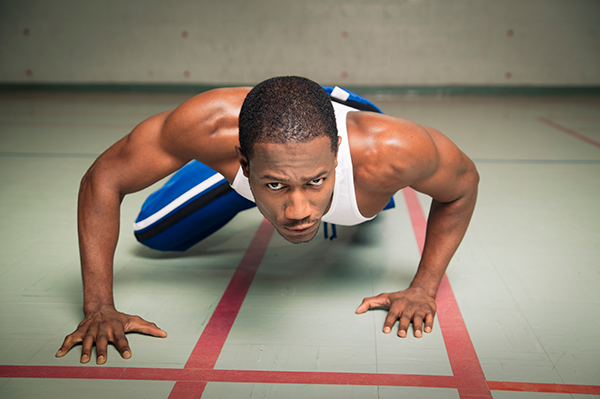
Life is all about challenges. Whether it involves school, relationships, work, hobbies, or the gym, we're always seeking new obstacles to overcome, and new goals to conquer. It's these challenges which add up and create our overall body of work - our legacy. If you've been training in the gym for some time, then your legacy is already one of a strong, athletic, fit person. You've learned the basics of nutrition, supplementation, recovery, and most interesting of all, training! You've grown stronger and leaner, developed your body to the point where you undoubtedly seen as a person who trains.
But, as with all things in life, you want more. You want to see just what kind of performance you can get out of your body. You don't just want to be strong and look good, but you're ready for one of the most primal and innate challenges offered by nature… how fast you can travel a fairly long distance. At some point, whether to impress a girl, or support a cause, or just to be able to know your own time, you are going to want to run a 5K race. Nearly every athlete goes through it at one time, a chance to fulfill their health and performance segment and at the same time maybe make their mark in some way.
If you're a well-rounded athlete, you may already be running a 5K and not know it. Five kilometers is about 3.11 miles. If you set your treadmill at 4 miles per hour and you walk for just over 45 minutes, then you have technically run 3.11 miles, or five kilometers. However, the sterile, flat, stationary nature of a treadmill is nothing like the environmental factors while influence a 5K race, and make it more interesting as a result. Let's look at some factors you will need to consider if you want to dive in.

Are you ready?
If you routinely run three miles in about 30 minutes on the treadmill, then you probably already possess the conditioning to put in a 5K race and perform moderately well. If you're a big bodybuilder, or just someone who doesn't do a lot of cardio, then running for thirty minutes straight might not be something you do on a regular basis. After all, those skinny hardgainers among us lose a lot of muscle when we do too much cardio, and a 5K is a lot of cardio! So if you're already running 3 miles in a half hour, you're ready to knock out some details and dive in for a race!
Sign up
Now it's time to sign up. Adding that date to your calendar creates a challenge. It'll motivate you to train several times each week, knowing it is essential for you to get in decent shape beforehand. Tell your family, friends, and peers, for added motivation. You can't back out if your wife and children are rooting you on! If you're not yet in 5K shape, you should plan your first race for about 2 months from now, giving you plenty of time to raise your cardio level to that needed to run the race.

Get your cardio up!
If you're not in shape yet, it's time to get there. Doing so is easy.You will want to look at your normal pace required for reaching the 3 mile mark. If you're only walking fast, at 3 or 3.1 miles per hour, then it'll take you about one hour to complete a 5K course. Now it's time to slowly bump up your speed each time you train. A simple increment of .1 mph each time you run (about 3-4 times each week) will have you at solid half-hour time in just a few weeks. Your body's muscles, lungs, and conditioning will adjust gradually to the increasing demand you are placing upon it.
Mix it up
If you're used to training solely indoors, then you'll want to gradually introduce your body to the rigors of outdoor running. Alternating workouts is a popular method. Inside on the treadmill, you have complete control over environment and pace, meaning you can slowly introduce your body to faster speeds with all other factors equal. This means your 3.1 mph can become 6.0 mph in a controlled and scientific manner. Running outside, you encounter weather elements, traffic, hills, and all sorts of terrain issues. You will want to include both forms of training, to cover your increased demand while at the same time conditioning your body for the rigors of the 'real world' of running!

Get smart
Many applications exist for your smart phone or watch which can help you monitor your speed, heart rate, distance, pace, and path traveled. Explore them but don't become dependent upon them for success. You will discover that in addition to working as a measurement tool, your app can become a motivational device. When your friends and family start cheering on your running times, you'll know you are doing something right!
Equipment matters
Many lifters just hop out the door and begin running on their happy way. They don't think about "equipment". It's just running, right? Unfortunately, the shoes you use to lift weights in the gym - typically standard athletic shoes - aren't going to offer the same level of support and reinforcement your body would prefer while running three plus miles. Running shoes are an absolute requirement! You are jumping, running, standing and striding, and the specific support offered by running shoes will help protect your feet, knees, back and other parts of the body. They aren't that expensive, but running without them can leave you injured very quickly!
Check the terrain
Running on concrete creates many issues for runners, particularly older runners whose cartilage may have run down from years of, well, living! Choose your running path wisely. Some people prefer tracks, and others opt for grass. The bravest runners see awesome improvements in their times by training in sand! Learn what surface you'll be facing for your scheduled 5K run and be prepared to run on that terrain.


